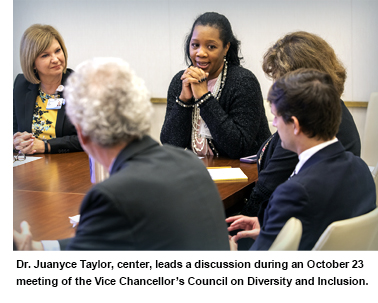Diversity and Inclusion 3.0
Good morning!
I had the opportunity recently to host a meeting of the Vice Chancellor’s Council on Diversity and Inclusion. This is the group charged with elevating and prioritizing matters relating to these vital ideals at the Medical Center, in concert with our staff in the Office of Diversity and Inclusion.
 As you might expect, this is a diverse, high-energy group and I was impressed with all that has been put in place in just three short years.
As you might expect, this is a diverse, high-energy group and I was impressed with all that has been put in place in just three short years.
When I became vice chancellor in 2015, one of the first positions I created and added to my Executive Cabinet was the Chief Diversity and Inclusion Officer. Not only did I want this work to be represented and visible at the highest level of leadership, this new institutional role would cover all three of our mission areas and coordinate diversity and inclusion efforts among them.
After a months-long national search, I was so pleased when we found Dr. Juanyce Taylor to be the most qualified candidate, and she was already right here at UMMC. Having literally grown up on this campus (her family lived in campus housing while her father, the late Dr. Zachary J. Taylor II, was in medical school here), no one knew us better, yet was so well-prepared in this subject matter.
And during that short span of three years, I would say the work of this office has become even more timely.
We seem to have reached an inflection point in our society where people are less civil to each other than at any time in my adult life on the basis of political, generational, gender, racial or other differences. In this environment, the work of diversity and inclusion is more important than ever.
Some of you may wonder, what are diversity and inclusion, and how do they differ? Diversity has to do with an organization and its programs being representative of the society in which it exists. Inclusion is more about making sure that all members of that organization and the people it serves feel welcome and respected.
Our own Dr. Demondes Haynes, vice chair for clinical affairs in the Department of Medicine, shared a quote that succinctly sums up the difference between these two ideals in an article he wrote for CHEST Physician (Oct. 2018) about the importance of diversity and inclusion in medicine. He quotes noted diversity advocate Vernā Myers who said, “Diversity is being invited to the party. Inclusion is being asked to dance.”
It’s important that UMMC be a leader in this effort, not just for the sake of our own internal values about the kind of organization we want to be, but because we have a responsibility to our learners to be mindful and intentional about our commitment to the value and dignity of all.
Accordingly, the staff of our Office of Diversity and Inclusion focuses on three broad areas:
- Developing strategies and initiatives to build “inclusive excellence” (I like that term!),
- Increasing education and training offerings to improve cultural competence at all levels, and
- Partnering with all mission areas in local efforts to support diversity and inclusion.
As reviewed in our meeting, the inventory of work that is currently underway is impressive. A number of groups, including whole classes of students and departments, have received training in “unconscious bias.” This is an insidious mindset we are all subject to and must guard against. More training along these lines will be offered, including online through HealthStream beginning in early 2019.
The office has promoted strategies for the intentional recruitment of underrepresented minorities among faculty, staff and students. A very important initiative I was glad to learn about is our enhanced outreach efforts to Mississippi’s historically black colleges and universities aimed at increasing admission rates of students from these institutions to our programs.
I’m sure most of you are aware of the lectures the office has organized featuring both local and national speakers. And the office is currently accepting nominations for the second year of “The Pillars” awards to recognize achievements in diversity and inclusion in several categories.
Another thing I’m pleased about is the office’s collaboration with other groups that have diversity and inclusion as core values — such as the Associated Student Body, the Group on Women in Medicine and Science, and various departments and schools. Rather than have all these activities centralized, it’s better to nurture and grow them in a distributed manner.
Finally, we have to measure our progress in diversity and inclusion efforts, both internally and as benchmarked against other institutions and national standards.
Intuitively we know diversity and inclusion are and must be core values for all of us at UMMC, but a passive approach won’t get the job done. I believe these values must be actively embraced with intention and resolve. And we’re making progress toward that end, on our journey toward a more just, a more equitable and A Healthier Mississippi.



